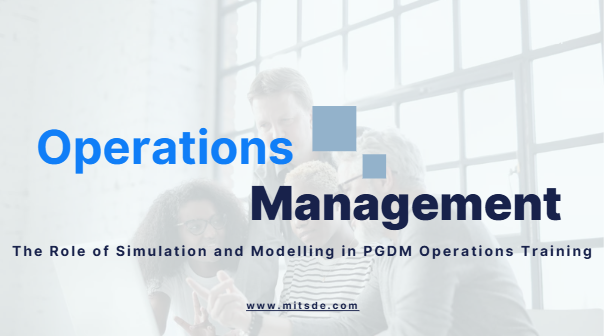
Businesses must make quick, strategic, and accurate decisions in the fast-paced, data-driven world of today. Postgraduate education, particularly in operations management, has changed to include much more than theory in order to prepare for these realities. The use of modeling and simulation in PGDM Operations Management training is among the most important developments in this progression.
In addition to receiving training in production, supply chain, and logistics, students who choose to pursue a PGDM in operations management are also exposed to state-of-the-art tools that help replicate real-world business situations. Their learning outcomes, decision-making abilities, and general job preparation are all improved by this analytical and immersive approach.
What precisely are modeling and simulation in this situation, and why are they so important? Let’s get started. 🚀
What is Simulation in PGDM in Operations Management? 🧠
In the context of operations management education, simulation is the practice of simulating actual company operations and procedures using digital tools and software. Students in PGDM programs, such as the one at MITSDE, build virtual representations of supply chains, production lines, inventory control, and logistics using simulation techniques.
Students can examine how systems operate in various scenarios in a risk-free setting with these simulations. Simulations provide useful insights without the expense of real-world mistakes, whether it’s testing how an unexpected increase in demand impacts inventory levels or how a production bottleneck slows down productivity.
Importance of Modelling in Operations Management 🧮
The foundation of simulations is modeling. It entails creating conceptual, graphical, or mathematical abstractions of real-world systems. These models are used by students in PGDM Operations Management to assess system performance, examine constraints, and experiment with various decision-making techniques.
The power of modeling to simplify complexity is what makes it so important in operations management. It turns a complex network of interconnected procedures into frameworks that are easy to comprehend and control. Models assist future operations managers in making well-informed, fact-based decisions on anything from resource allocation to supply chain optimization.
Benefits of Simulation in PGDM Operations Training 🎯
In today’s intricate business climate, using simulations in operations training is not merely a fad; it is a requirement. The following are some noteworthy advantages of simulation in PGDM operations training:
✅ Real-Time Problem Solving: Students can test solutions to problems such as demand fluctuations or machine failures.
✅ Risk-Free Learning Environment: Students can try out various tactics without worrying about losing in the real world.
✅ Enhanced Analytical Skills: Students are encouraged to measure KPIs, forecast outcomes, and evaluate data through simulations.
✅ Increased Engagement: Interactive simulation technologies increase the impact and engagement of the learning process.
✅ Industry Relevance: Since many firms use the same simulation techniques, graduates are prepared for the workforce.
How Modelling Improves Decision-Making in Operations 🧩
Any operations manager needs to be able to make decisions. However, without the proper resources, judgments may be made based more on conjecture than facts. The modeling comes into its own here.
By using mathematical and computer-based models, students can:
🔍 Identify bottlenecks in processes
🔍 Analyze resource utilization
🔍 Evaluate different process configurations
🔍 Conduct “what-if” analyses for better forecasting
🔍 Minimize costs and maximize efficiency
Essentially, modeling transforms abstract problems into structured answers, which enhances operational decision-making. It fosters a strategic thinking approach, which is essential in the tech-driven, multinational industries of today.
Role of Digital Tools in PGDM Operations Management 💻⚙️
In essence, modeling improves operational decision-making by converting abstract problems into organized solutions. It encourages a method of strategic thinking, which is crucial in today’s tech-driven, globalized companies.
Some of the most widely used digital tools include:
🛠️ Arena – Used for discrete event simulation
🛠️ Simul8 – Ideal for simulating complex business environments
🛠️ AnyLogic – Offers agent-based, system dynamics, and discrete-event modelling
🛠️ Tableau/Power BI – For visualizing operational data
🛠️ Excel Solver – For linear programming and optimization
Leading business schools frequently include these tools in their PGDM in Operations Management curricula. Students gain expertise in converting operational data into insights that can be put to use by becoming skilled with these platforms.
What Simulation Techniques Are Taught in PGDM Operations? 🧪
Students are exposed to a variety of simulation approaches during the PGDM journey, including:
🔸 Monte Carlo Simulation – Useful for understanding the impact of risk and uncertainty
🔸 Discrete Event Simulation (DES) – Models systems where events occur at distinct times
🔸 System Dynamics – Focuses on the behavior of complex systems over time
🔸 Agent-Based Modelling – Simulates individual agents and their interactions
These simulation methods give students a better understanding of the dynamics of real-time operations systems and equip them to confidently take on issues at the industrial level.
PGDM in Operations Management Curriculum Insights 📚
The PGDM in Operations Management program at schools like MITSDE is thoughtfully crafted to provide both theoretical foundation and real-world application. In order to guarantee constant and practical learning, simulation and modeling are weaved throughout the course rather than being stand-alone subjects.
Here’s a glimpse of some courses that often feature simulation and modelling elements:
✅ Operations Research
✅ Production and Inventory Control
✅ Logistics and Distribution
✅ Quality Management
In addition to learning how to create models, students also learn how to analyze the results and use them to inform strategic choices that resemble actual situations.
How Are Case Studies Used in PGDM Operations Management Training? 📊📝
Many PGDM schools incorporate case studies into their operations management coursework to help close the theory-practice gap. These case studies frequently center on:
📍 Implementing lean manufacturing in automotive industries
📍 Redesigning a logistics network for a global FMCG brand
📍 Simulation-based capacity planning in a hospital
📍 Demand forecasting for seasonal products in retail
📍 Inventory optimization using Just-In-Time (JIT) in electronics manufacturing
Students are encouraged to engage in real-world projects and simulations that replicate these situations at MITSDE, which helps them develop a strong problem-solving mindset and practical experience.
Why MITSDE Stands Out for PGDM in Operations Management ⭐🎓
Selecting the appropriate specialty and institution are equally crucial. The MIT School of Distance Education, or MITSDE, has been a pioneer in providing operations management education that is both industry-relevant and hands-on.
Here’s why MITSDE is an excellent choice:
🔹 Flexible online learning with live faculty interactions
🔹 Case-study based curriculum
🔹 Access to modern simulation and modelling tools
🔹 24/7 student support
🔹 Recognized by AICTE
By using digital tools, collaborative projects, and simulations, MITSDE makes sure that students experience real-world operations in addition to learning.
Conclusion: Where Learning Meets Innovation 🎓✨
Operations management education is being transformed by simulation and modeling. These resources give theories life and turn classrooms into operational business labs. Students gain the technical know-how, strategic thinking, and analytical mentality necessary to succeed in challenging corporate settings through this hands-on study.
Future leaders are being molded by this potent combination of education and technology, from comprehending what simulation is in PGDM in Operations Management to using it across sectors. There has never been a better moment to invest in your future because organizations like MITSDE provide a cutting-edge and all-encompassing approach.
💼 Ready to master the tools of tomorrow, today?


